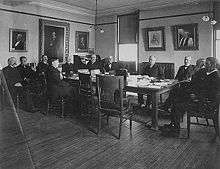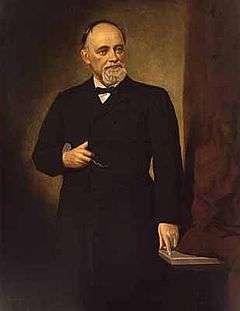John S. Pillsbury
| John Sargent Pillsbury | |
|---|---|
|
John Sargent Pillsbury | |
| 8th Governor of Minnesota | |
|
In office January 7, 1876 – January 10, 1882 | |
| Lieutenant |
James Wakefield Charles A. Gilman |
| Preceded by | Cushman Davis |
| Succeeded by | Lucius Frederick Hubbard |
| Personal details | |
| Born |
July 29, 1827 Sutton, New Hampshire, U.S. |
| Died |
October 18, 1901 (aged 74) Minneapolis, Minnesota, U.S. |
| Resting place | Lakewood Cemetery in Minneapolis, Minnesota. |
| Political party | Republican |
| Spouse(s) | Mahala Fisk (1832–1910) |
| Profession |
Politician Businessman Philanthropist |
| A member of Chi Psi | |
John Sargent Pillsbury (July 29, 1827 – October 18, 1901) was an American politician, businessman, and philanthropist. A Republican, he served as the eighth Governor of Minnesota from 1876 to 1882. He was a co-founder of the Pillsbury Company.
Early life and career
Pillsbury was born in Sutton, New Hampshire of English descent, the son of John and Susan (Wadleigh) Pillsbury. He was a descendant of Joshua Pillsbury, who emigrated from England to Newburyport, Massachusetts in 1640.[1] In 1851, he opened a store in Warner, New Hampshire, partnering with Walter Harriman, a future Governor of New Hampshire and Civil War general.
Career
Pillsbury Company
Pillsbury came to Minnesota from the Eastern U.S. in 1855 and settled in St. Anthony (now part of Minneapolis). The entrepreneur tried his hand at several different types of businesses (after his business with Walter Harriman) including hardware, real estate, and lumber, though his greatest success came when he co-founded C. A. Pillsbury and Company[2] along with his nephew Charles Alfred Pillsbury, for whom the company was named.[3][4] Pillsbury attended the University of Minnesota, where he joined Chi Psi.
Political career
After the American Civil War, Pillsbury was elected as a third class companion of the Military Order of the Loyal Legion of the United States.[5]
Pillsbury served in the Minnesota Senate for several years before becoming the eighth Governor of Minnesota.[6] He served as governor from January 7, 1876, until January 10, 1882.[7] During the Grasshopper Plague of 1877, Governor Pillsbury called for a day of prayer on April 26, 1877.[8] A subsequent sleet storm killed all the grasshoppers. In Cold Spring, Minnesota, a chapel was built to honor the miracle.[9]
Philanthropist

Pillsbury was a noted philanthropist and often anonymously donated funds to causes he favored. In particular, he helped the University of Minnesota recover from debt in its early years, and later served as a regent. Since then, he has become known as "The Father of the University."[10] Pillsbury Hall at the University of Minnesota is named in his honor.[11][12]
Personal life
Pillsbury married Mahala Fisk on November 3, 1856.[13] He and Mahala had four children, daughters Addie, Susan May, and Sarah Belle, and then son Alfred.[14] Addie married Charles M. Webster, but died at the age of 25; Susan married Fred B. Snyder and died at the age of 28; Sarah Belle married Edward C. Gale, an area lawyer and son of the area's first real estate developer, Samuel Chester Gale. Edward Gale was also an art collector and contributed to the Minneapolis Institute of Arts (MIA) as well.[15] Alfred did not go into business, but instead became an art collector. When he died in 1950, the works were donated to MIA.[16][17]
Pillsbury died on October 18, 1901 and is interred in Lakewood Cemetery in Minneapolis, Minnesota.[18]

Quote
A 1901 magazine article described him as follows:
[Pillsbury's] impulse always was: "Act; act now; act effectively; act for the greatest good." He belonged to the type of man who "does things."[19]— Horace B. Hudson, The American Monthly Review of Reviews
References
- ↑ The National cyclopaedia of American biography: Volume 10 – Page 65
- ↑ "John Pillsbury Biography". Governors of Minnesota. Retrieved January 1, 2014.
- ↑ Elliott, Alan (1998). A Daily Dose of the American Dream: Stories of Success, Triumph, and Inspiration. Thomas Nelson Inc. p. 29.
- ↑ Morris, Evan (2004). From Altoids to Zima: The Surprising Stories Behind 125 Famous Brand Names. Simon and Schuster. p. 68.
- ↑ "Military Order of the Loyal Legion of the United States". Military Order of the Loyal Legion of the United States. Retrieved January 3, 2014.
- ↑ Carney, Mary Vance (1918). Minnesota: the star of the North. D. C. Heath & co. p. 218.
- ↑ "John Pillsbury Biography". Governors of Minnesota. Retrieved January 1, 2014.
- ↑ Dregni, Eric (2006). Weird Minnesota: Your Travel Guide to Minnesota's Local Legends and Best Kept Secrets. Sterling Publishing Company, Inc. p. 74.
- ↑ "Minnesota Gov. John Pillsbury Called for Day of Prayer to End Grasshopper Plague". American Profile. Retrieved January 3, 2014.
- ↑ Carney, Mary Vance (1918). Minnesota: the star of the North. D. C. Heath & co. p. 218.
- ↑ Minnesota. University (1921). Bulletin. Minnesota. University. p. 67.
- ↑ Millett, Larry (2007). AIA Guide to the Twin Cities: The Essential Source on the Architecture of Minneapolis and St. Paul. Minnesota Historical Society. p. 132.
- ↑ Higginson Book Company (1900). Encyclopedia of Biography of Minnesota: Illustrated with Steel Plate and Copper Plate Engravings. Higginson Book Company. p. 125.
- ↑ "Mahala Pillsbury Biography". Governors of Minnesota. Retrieved January 1, 2014.
- ↑ Press Biographical Company (1902). The Successful American, Volumes 5–6. Press Biographical Company. p. 19.
- ↑ "Explore the Collection". Minneapolis Institute of Arts. Retrieved January 1, 2014.
- ↑ "The Art of Asia". Minneapolis Institute of Arts. Retrieved January 1, 2014.
- ↑ "Mahala Pillsbury Biography". Governors of Minnesota. Retrieved January 1, 2014.
- ↑ Hudson, Horace B. (December 1901). "A Public Servant of the Northwest: The Fruitful Career of the Late Governor John S. Pillsbury, of Minnesota". The American Monthly Review of Reviews. 24: 690.
External links
| Wikimedia Commons has media related to John S. Pillsbury. |
- Biographical information and his gubernatorial records are available for research use at the Minnesota Historical Society.
- John Sargent Pillsbury in MNopedia, the Minnesota Encyclopedia
- The Washburn-Fair Oaks Historic District: History and Walking Tour. Hennepin History Museum.
- Pillsbury Hall (University of Minnesota Geology Department).
- Minnesota Legislators Past and Present
- John Sargeant Pillsbury bio at the National Governors Association
- John S. Pillsbury at Find a Grave
Further reading
Sturdevant, Lori (2011). The Pillsburys of Minnesota. Minneapolis: Nodine Press. ISBN 978 1 935666 22 6.
| Political offices | ||
|---|---|---|
| Preceded by Cushman Davis |
Governor of Minnesota 1876–1882 |
Succeeded by Lucius Frederick Hubbard |


